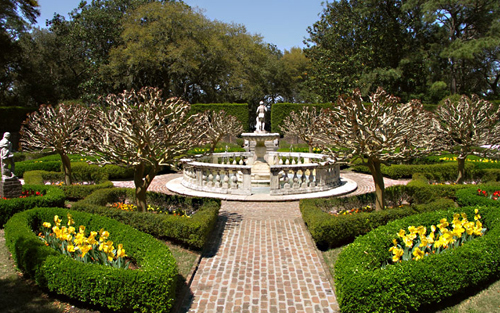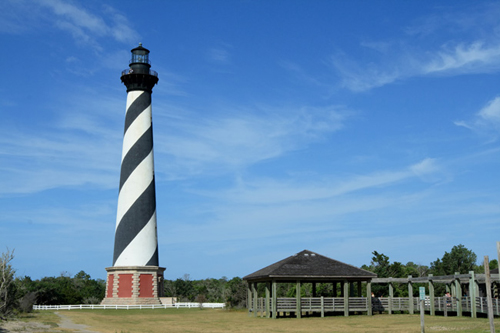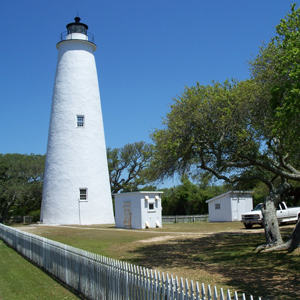Wright Brothers National Memorial
Site of the world's first controlled powered flight on December 17, 1903. The Visitor Center features full-scale reproductions of the Wright 1903 Powered Flyer and interpretive presentations. A pavilion boasts an exhibit hall with special exhibits, including a replica of the 1902 Wright Glider and a multipurpose auditorium.
The grounds include historical markers of each attempted powered flight, replica camp buildings and a 60-foot granite monument on top of Big Kill Devil Hill,- (a 90-foot dune) honoring the Wright brothers.


Elizabethan Gardens
Fun for the entire family at this 16th century pleasure garden created by The Garden Club of North Carolina as a living memorial to the lost colonists. Highlights include the thatched gazebo, Shakespearean herb garden, flower bordered walkways, antique garden statuary and formal sunken gardens.
History, mystery and fantasy are combined in these special gardens, which are a memorial to the first English colonists who came to North America in 1584-1587 and “walked away through the dark forest into history” as memorialized in Paul Green’s symphonic drama, “The Lost Colony”. For here and nowhere else, Sir Walter Raleigh made initial attempts to colonize the New World under Queen Elizabeth I. Truly this hallowed site is the birthplace of America.The Elizabethan Gardens, located on this same site which the colonists first landed, is full of history and beauty in this tranquil setting on the shores of Roanoke Island. Founded and supported by the Garden Club of North Carolina, Inc. and featured in many landscape books and calendars, The Elizabethan Gardens is one of the finest examples of gardens of this period. Truly, it stands out as the crown jewel of Roanoke Island.
Outer Banks History Center
Find answers to local trivia questions, explore family history or find images from the past at the Outer Banks History Center, a regional archives and research library administered by the North Carolina State Archives (Department of Cultural Resources). Holdings include books and magazines, thousands of photographs, post cards and maps, personal papers and organizational archives, oral histories and other recordings, and much more. The center will celebrate its 20th anniversary in 2009 with a special exhibit in the History Center Gallery and series of programs.


Cape Hatteras Lighthouse
The Cape Hatteras Lighthouse, also known as America’s Lighthouse, is the tallest brick beacon in the country standing 208 feet. The familiar black and white spiral-striped landmark serves as a warning to mariners of submerged and shifting sandbars which extend almost twenty miles off Cape Hatteras into the Atlantic Ocean. They are known as the Diamond Shoals.
The present lighthouse, officially completed and lit in December 1870, is the second built of three that have been constructed in Buxton. The first Cape Hatteras Lighthouse was built in 1803. It was a sandstone structure 90 feet tall that projected an insufficient light beam using a collection of Argand lamps and reflectors. Sitars to a new height of 150 feet in 1854, and a first order Fresnel lens was installed, the most powerful of its day. The lamp was also fueled by whale oil, as was the previous light. During the Civil War in 1861, retreating Confederate soldiers took the Fresnel lamp from the lighthouse, to keep it out of Union hands. North Carolina’s Outer Banks and the inlets that allowed passage between them were considered of utmost strategic importance by Union forces to keep supplies from reaching the interior of the Confederate aligned southern state by sea.
Ocracoke Lighthouse
The Ocracoke Lighthouse is North Carolina’s oldest operating lighthouse. In 1798, a 54 foot wooden tower was built on the point of Ocracoke Inlet to mark the channel. Soon afterward, the inlet shifted, rendering the lighthouse ineffective. It was replaced by a light vessel in the inlet in 1820, but by 1822 this structure was rendered useless yet again by shifting sands, and Congress authorized the funding to build the present tower, which stands 75 feet tall and shines 14 miles out to sea. As a harbor light, it emits a constant fixed beam. Not open for climbing. Ocracoke Island is accessible by a free ferry. Free admission.
